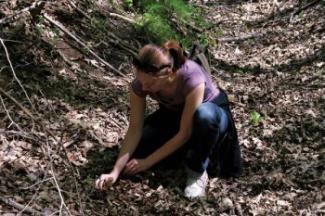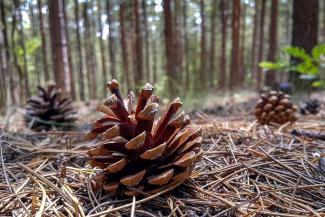Foraging on the Caribou-Targhee

Morel harvesting on the forest
Welcome to the wild pantry of the Caribou-Targhee National Forest! Spanning 2.63 million acres across southeastern Idaho, western Wyoming, and a touch of Utah, this sprawling landscape offers more than stunning views and timber—it’s a forager’s paradise. Here, you can gather non-wood forest products like pinecones, huckleberries, mushrooms, medicinal plants, and seeds or nuts for personal use, no permit required. Whether you’re after a handful of berries for a trail snack or cones for a rustic craft, foraging connects you to the forest’s rhythms and traditions. Ready to explore? Here’s everything you need to know to forage responsibly in Caribou-Targhee.
What’s Out There to Forage?
Non-wood forest products are nature’s gifts that don’t involve cutting trees. In Caribou-Targhee, nestled near the Greater Yellowstone Ecosystem, you’ll find a bounty of edible, medicinal, and craft-ready treasures. Best of all, you can harvest these for personal enjoyment without a permit—just follow the guidelines to keep the forest thriving.
Your Foraging Favorites
Pinecones
- How Much: Up to 5 gallons per trip (think a large bucket)—plenty for wreaths or fire starters.
- Best Areas: Look under lodgepole and ponderosa pines in Island Park or near Soda Springs. Dry, open forests with sunny slopes are cone central.
- Season: Late summer to fall (August-October), when cones ripen and hit the ground.
- Tips: Grab fallen cones—green ones on trees aren’t ready. A sturdy sack is all you need. Stick to your limit to leave some for wildlife.
Huckleberries

Huckleberries
- How Much: Up to 1 gallon per person per day—enough for a pie or a sweet trail treat.
- Best Areas: High-elevation haunts like the Teton Division near Driggs or Big Hole Mountains near Victor. Shady slopes above 6,000 feet are your sweet spot.
- Season: Mid-July to late August, peaking with warm days and cool nights.
- Tips: Pick with a bucket or cloth pouch; your fingers work best. Bears love these—make noise and stash your haul safely.
Mushrooms
- How Much: 1-2 pounds per day (a small grocery bag)—perfect for a wild meal.
- Best Areas: Moist nooks in Palisades near Swan Valley (chanterelles) or fire-scarred zones in Ashton/Island Park (morels).
- Season: Spring (April-May) for morels after burns; late summer to fall (August-October) for others post-rain.
- Tips: Cut stems with a knife, leave roots. Use a basket to keep them fresh. ID with a guide—some lookalikes are toxic.
Medicinal Plants
- How Much: 1-2 quarts of leaves/berries or a few plants (e.g., 5 elderberry stalks) per outing.
- Best Areas: Sunny meadows near Pocatello for yarrow; creek sides in Montpelier for elderberry.
- Season: Summer (June-August) for herbs; late summer (August-September) for berries.
- Tips: Snip with shears, spare the roots. Rare plants deserve care—take only what you’ll use.
Seeds and Nuts
- How Much: Up to 1 quart of pine nuts or 2 pounds of seeds per trip.
- Best Areas: Pinyon pines in dry Dubois or St. Anthony Sand Dunes for nuts; grassy flats near Soda Springs for seeds.
- Season: Late summer (August-September) for pine nuts; fall (September-October) for seeds.
- Tips: Shake cones for pine nuts or hand-pick seeds. A small sack does the trick. Pinyons are patchy scout ahead.
Getting Started: Foraging Basics
No permits, no fuss—just head into the forest with the right tools and a respect for the land. Here’s how to kick off your foraging adventure:
- Gear Up: Pack a basket or cloth bag (plastic traps moisture), gloves, a small knife or shears, and a GPS or map—cell service can fade. A guidebook or app helps with IDs.
- Timing: Match your target to its season—berries in summer, cones in fall, mushrooms after rain.
- Where to Go: Stick to public forest land. Ranger District maps (available in places like Idaho Falls or Driggs) show you the way and keep you off private parcels.
The Foraging Adventure
Picture this: You’re scouring a Teton ridge for huckleberries, the air thick with pine and your hands-stained purple. Or maybe you’re tracing a quiet trail in Palisades, unearthing chanterelles under damp leaves. Foraging in Caribou-Targhee is a scavenger’s thrill—sagebrush flats, alpine slopes, and dense conifer stands each hide their own prizes. Learn the land’s cues, and every trip becomes a discovery.

Pinecones on the Forest Floor
Guidelines for Responsible Foraging
No permit doesn’t mean no rules. Keep the forest healthy for everyone—human and wild—with these simple practices:
- Stick to Limits: Suggested amounts (like 1 gallon of berries) ensure plenty stays for wildlife and regrowth.
- Stay Legal: Forage only on public land—private plots are scattered within the forest.
- Know Your Finds: Misidentifying can harm you (mushrooms) or the ecosystem (rare plants). When unsure, pass it up.
- Tread Lightly: Don’t trample or dig more than needed; pack out all trash.
- Personal Use Only: No selling—just enjoy your haul at home.
Trail Tips for Foragers
- Beat the Rush: Hit the trails on weekdays or at dawn to avoid berry crowds.
- Weather Watch: Mountain storms roll in fast—bring layers and check forecasts.
- Tick Alert: Spring and summer bring ticks in grassy or brushy spots. Wear long pants, tuck them into socks, and check yourself after.
- Wildlife Wise: Bears, moose, and elk call this home. Make noise, store food safely, and give them space.
- Share the Loot: Got extra? Swap huckleberries for a neighbor’s jam or cones for a craft.
Why Forage in Caribou-Targhee?
Foraging here is a taste of the wild—huckleberry pancakes from your own pick or tea steeped from forest herbs. It’s free, sustainable, and ties you to a legacy of locals who’ve roamed these hills for generations. Every handful you gather keeps you connected to this living landscape.
Plan Your Foraging Trip
Ready to forage? Contact a Ranger District—think Pocatello, Ashton, or Soda Springs—for maps, conditions, or insider tips. With no permit needed, all it takes is your gear and a sense of adventure. From pinecones to pine nuts, Caribou-Targhee’s non-wood bounty is waiting. Lace up your boots and dive into the forest’s wild offerings today!



